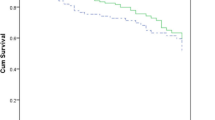Abstract
Pseudomonas aeruginosa bloodstream infection (BSI) is predominantly acquired in the hospital setting. Community-onset infection is less common. Differences in epidemiology, clinical features, microbiological factors and BSI outcomes led to the separation of bacterial community-onset BSI into the categories of healthcare-associated infection (HCAI) and community-acquired infection (CAI). Community-acquired P. aeruginosa BSI epidemiology is not well defined in the literature. In addition, it is also not clear if the same factors separate CAI and HCAI BSI caused by P. aeruginosa alone. A retrospective multicentre cohort study was performed looking at P. aeruginosa BSI from January 2008 to January 2011. Strict definitions for HCAI and CAI were applied. Extensive epidemiological, clinical and outcome data were obtained. Thirty-four CAI episodes and 156 HCAI episodes were analysed. The CAI group could be characterised into seven distinct categories based on comorbidities and clinically suspected source of infection. A pre-morbidly healthy group could not be identified. On multivariate analysis, the presence of a rheumatological or a gastrointestinal comorbidity were significantly associated with CAI. There was no significant difference in length of stay or rates of mortality between HCAI or CAI. The clinician should not be falsely reassured regarding outcome by the diagnosis of a community-acquired P. aeruginosa BSI.

Similar content being viewed by others
References
Friedman ND, Kaye KS, Stout JE, McGarry SA, Trivette SL, Briggs JP, Lamm W, Clark C, MacFarquhar J, Walton AL, Reller LB, Sexton DJ (2002) Health care-associated bloodstream infections in adults: a reason to change the accepted definition of community-acquired infections. Ann Intern Med 137(10):791–797
Vallés J, Calbo E, Anoro E, Fontanals D, Xercavins M, Espejo E, Serrate G, Freixas N, Morera MA, Font B, Bella F, Segura F, Garau J (2008) Bloodstream infections in adults: importance of healthcare-associated infections. J Infect 56(1):27–34
Son JS, Song JH, Ko KS, Yeom JS, Ki HK, Kim SW, Chang HH, Ryu SY, Kim YS, Jung SI, Shin SY, Oh HB, Lee YS, Chung DR, Lee NY, Peck KR (2010) Bloodstream infections and clinical significance of healthcare-associated bacteremia: a multicenter surveillance study in Korean hospitals. J Korean Med Sci 25(7):992–998
Kollef MH, Zilberberg MD, Shorr AF, Vo L, Schein J, Micek ST, Kim M (2011) Epidemiology, microbiology and outcomes of healthcare-associated and community-acquired bacteremia: a multicenter cohort study. J Infect 62(2):130–135
Lenz R, Leal JR, Church DL, Gregson DB, Ross T, Laupland KB (2012) The distinct category of healthcare associated bloodstream infections. BMC Infect Dis 12:85
Charlson ME, Pompei P, Ales KL, MacKenzie CR (1987) A new method of classifying prognostic comorbidity in longitudinal studies: development and validation. J Chronic Dis 40(5):373–383
Chow JW, Yu VL (1999) Combination antibiotic therapy versus monotherapy for gram-negative bacteraemia: a commentary. Int J Antimicrob Agents 11(1):7–12
Horan TC, Andrus M, Dudeck MA (2008) CDC/NHSN surveillance definition of health care-associated infection and criteria for specific types of infections in the acute care setting. Am J Infect Control 36(5):309–332
European Committee on Antimicrobial Susceptibility Testing (EUCAST) (2013) Breakpoint tables for interpretation of MICs and zone diameters. Available online at: http://www.eucast.org/clinical_breakpoints/
Clinical and Laboratory Standards Institute (CLSI) (2012) Performance standards for antimicrobial susceptibility testing; Twenty-second informational supplement. CLSI document M100-S22. CLSI, Wayne, PA, USA
Moon HW, Ko YJ, Park S, Hur M, Yun YM (2014) Analysis of community- and hospital-acquired bacteraemia during a recent 5-year period. J Med Microbiol 63(Pt 3):421–426
De Bus L, Coessens G, Boelens J, Claeys G, Decruyenaere J, Depuydt P (2013) Microbial etiology and antimicrobial resistance in healthcare-associated versus community-acquired and hospital-acquired bloodstream infection in a tertiary care hospital. Diagn Microbiol Infect Dis 77(4):341–345
Parkins MD, Gregson DB, Pitout JD, Ross T, Laupland KB (2010) Population-based study of the epidemiology and the risk factors for Pseudomonas aeruginosa bloodstream infection. Infection 38(1):25–32
Hattemer A, Hauser A, Diaz M, Scheetz M, Shah N, Allen JP, Porhomayon J, El-Solh AA (2013) Bacterial and clinical characteristics of health care- and community-acquired bloodstream infections due to Pseudomonas aeruginosa. Antimicrob Agents Chemother 57(8):3969–3975
Shooter RA (1971) Bowel colonization of hospital patients by Pseudomonas aeruginosa and Escherichia coli. Proc R Soc Med 64(9):989–990
Huang YC, Lin TY, Wang CH (2002) Community-acquired Pseudomonas aeruginosa sepsis in previously healthy infants and children: analysis of forty-three episodes. Pediatr Infect Dis J 21(11):1049–1052
Enoch DA, Kuzhively J, Sismey A, Grynik A, Karas JA (2013) Pseudomonas aeruginosa bacteraemia in two UK district hospitals. Infect Dis Rep 5(1):e4
Magiorakos AP, Srinivasan A, Carey RB, Carmeli Y, Falagas ME, Giske CG, Harbarth S, Hindler JF, Kahlmeter G, Olsscomoron-Liljequist B, Paterson DL, Rice LB, Stelling J, Struelens MJ, Vatopoulos A, Weber JT, Monnet DL (2012) Multidrug-resistant, extensively drug-resistant and pandrug-resistant bacteria: an international expert proposal for interim standard definitions for acquired resistance. Clin Microbiol Infect 18(3):268–281
Acknowledgements
We would like to thank the participating hospitals and laboratories for allowing us to conduct this study: Greenslopes Private Hospital, Mater Pathology, Mater Private Hospital, Mater Public Hospital, Princess Alexandra Hospital, Pathology Queensland, Royal Brisbane and Women’s Hospital, St Andrew’s Private Hospital, Sullivan Nicolaides Pathology and The Prince Charles Hospital.
Author information
Authors and Affiliations
Corresponding author
Ethics declarations
Conflict of interest
The authors declare they have no conflicts of interest.
Funding
No funding of any form received for the research carried out.
Ethics approval
For this type of study, formal consent is not required.
Rights and permissions
About this article
Cite this article
McCarthy, K.L., Paterson, D.L. Community-acquired Pseudomonas aeruginosa bloodstream infection: a classification that should not falsely reassure the clinician. Eur J Clin Microbiol Infect Dis 36, 703–711 (2017). https://doi.org/10.1007/s10096-016-2852-0
Received:
Accepted:
Published:
Issue Date:
DOI: https://doi.org/10.1007/s10096-016-2852-0




